MANAGEMENT PROGRAM BULLETIN
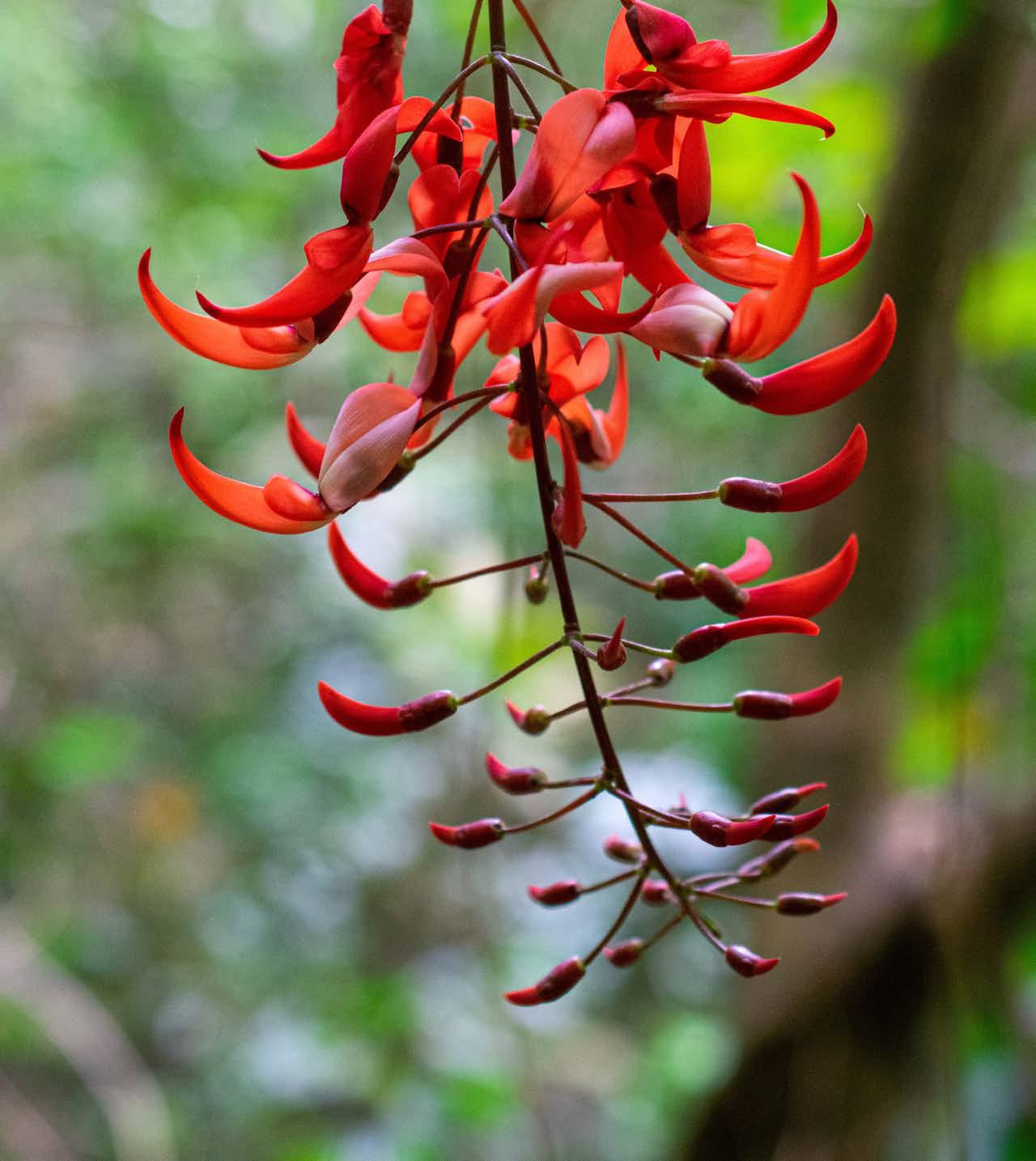

20222023 ISSUE
C elebrating 25 Y ears of C onservation
The nuku i'iwi (Strongylodon ruber) is so named because of the flower's striking resemblance to the beak of the i'iwi bird (Drepanis coccinea), a native honeycreeper, whose salmon colored deeply curved beak is believed to be adapted to accessing necatar in tubular flowers. Pictured here and on the cover, the nuku i'iwi is one of many Species at Risk (SAR) that benefit from the threat management actions perfomred by the Army Natural Resources Program, O'ahu.
 MAKOA DE ALMEIDA
MAKOA DE ALMEIDA
MOVING FORWARD TOGETHER

The Hawaiian islands are the most geographically isolated group of islands on Earth. They are also home to more than 500 federally listed threatened and endangered species and countless cultural and archaeological resources.

A number of these unique resources can be found on U.S. Army installations and training areas. From plants and birds , to snails, bats and insects, the Army's natural resources programs on O'ahu and Hawai'i Island manage more than 120 threatened and endangered species. Likewise, the Army's cultural resources programs in Hawai'i manage more than 3,000 significant cultural resources, including historic sites, structures, buildings and artifacts.

The Ecosystem Management Program Bulletin is designed to educate the public and the military community about the unique resources on Armymanaged lands and the Army's efforts to conserve them. This issue celebrates and recognizes 25 years of conservation with the Army Natural Resources Program, O'ahu. Our hope is to encourage a collective conservation ethic, foster innovation and inspire and expand opportunities for collaboration and partnership with academia, industry and beyond.
The Army's core mission is to train our Soldiers so they are ready when called, and this mission is directly tied to the environmental stewardship of the resources in our care. Protecting the environment means sustaining the mission and securing the future.
U.S. ARMY GARRISON HAWAI'I
 Steven B. McGunegle Colonel, U.S. Army Commanding
Steven B. McGunegle Colonel, U.S. Army Commanding

Published for the U.S. Army Garrison Hawai'i by the Office of the Vice President for Research and Innovation
INTRODUCTION
CONTRIBUTORS
KAPUA KAWELO

Kapua Kawelo is one of the original members of the USAG-HI natural resources team. With over 20 years of endangered species work under her belt, the University of California, Davis graduate will do whatever it takes to protect O'ahu's rarest plants and animals from introduced threats.
.
Kapua is a natural resource manager with U.S. Army's DPW Environmental Division, Natural Resources Program.
TIM CHAMBERS
Tim Chambers oversees the Army's rare plant program on O'ahu. Prior to joining the Army's natural resources team, Tim worked extensively in the areas of seed conservation and restoration plant material development in the Eastern United States with Seeds of Success, the MidAtlantic Regional Seed Bank and the Greenbelt Native Plant Center, New York City Parks and Recreation.
Tim is a rare plant program coordinator with the University of Hawai'i, Office of the Vice President for Research and Innovation, working for U.S. Army's Natural Resources Program on O'ahu.

LENA SCHNELL
Lena Schnell has been managing natural resources in Hawai'i for almost 30 years. She has worked with the Peregrine Fund, the National Park Service, and U.S. Geological Survey. Her career focused at Pōhakuloa Training Area where she has worked conserving threatened and endangered species and their habitats since 1995.


Lena is a senior program manager with the Center of Environmental Management of Military Lands, working for U.S. Army's Natural Resources Program at Pōhakuloa Training Area.
JESSICA ADINOLFI
Jessica worked as a botanist and biologist in California for 10 years and studied at the National Botanical Gardens on Kaua'i. She is grateful for her conservation career and the opportunities it provides for learning, connecting and growing with the people and nature in Hawai'i.
Jessica is a biologist with U.S. Army's DPW Environmental Division, Natural Resources Program.

"I am constantly inspired by the grandeur and majesty of Pōhakuloa and grateful to work toward conserving these landscapes."
"Endangered species management is integral to ecosystem health. When species become rare and endangered, it is an indicator that the system is unravelling."
" When it comes to new, potentially devastating pest introductions, it's not a matter of if—but when. There will be more. Those keeping watch must be even more vigilant to protect the valuable resources of these islands."
"The recent 97 Species at Risk (SAR) identified on Army training areas bring new opportunities for overlapping natural resource management."
CONTENTS
25 Years of Army Rare Plant Conservation: Reflections & Next Steps Forward
From surveys to seed banking and thousands of rare plantings in-between passionate members of the Army's Natural Resources Program on O'ahu continue to refine management actions to protect some of the rarest plants on the planet.
BY KAPUA KAWELO AND TIM CHAMBERS
A New Species of Pamakani to Receive Scientific Recognition
Follow the complex journey of an undescribed species of Tetramolopium at Pōhakuloa Training Area, from initial discovery in 1989 to the current day challenges of naming and protecting a plant that is new to science.
BY LENA SCHNELL
Endangered O'ahu Loulu Under Threat From Coconut Rhinoceros Beetles
An eye-opening account of the environmental and cultural impacts from a single species introduction and the effort that is required to manage and contain this invasive threat.
BY JES SICA ADINOLFI
REPI: Readiness and Environmental Protection Integration
A reflection on past and present REPI projects and the collaborative multi-agency approach to support watershed conservation, coastal and climate resilience, and preservation in Hawai'i.
EDITOR
Kimberly Welch
Outreach/Volunteer Program Specialist
Office of the Vice President for Research and Innovation
DISTRIBUTION
This magazine is produced on a yearly basis and distributed electronically to more than 2,000 readers.
CONNECT WITH US
Have a comment, suggestion, reprint request or want to be on the mailing list? Contact us at OUTREACH@OANRP.COM
All photos, maps, and illustrations are courtesy of U.S. Army, Office of the Vice President for Research and Innovation, and Center for Environmental Management of Military Lands, unless otherwise noted.
24
REPI
4 14
REVIEW
30
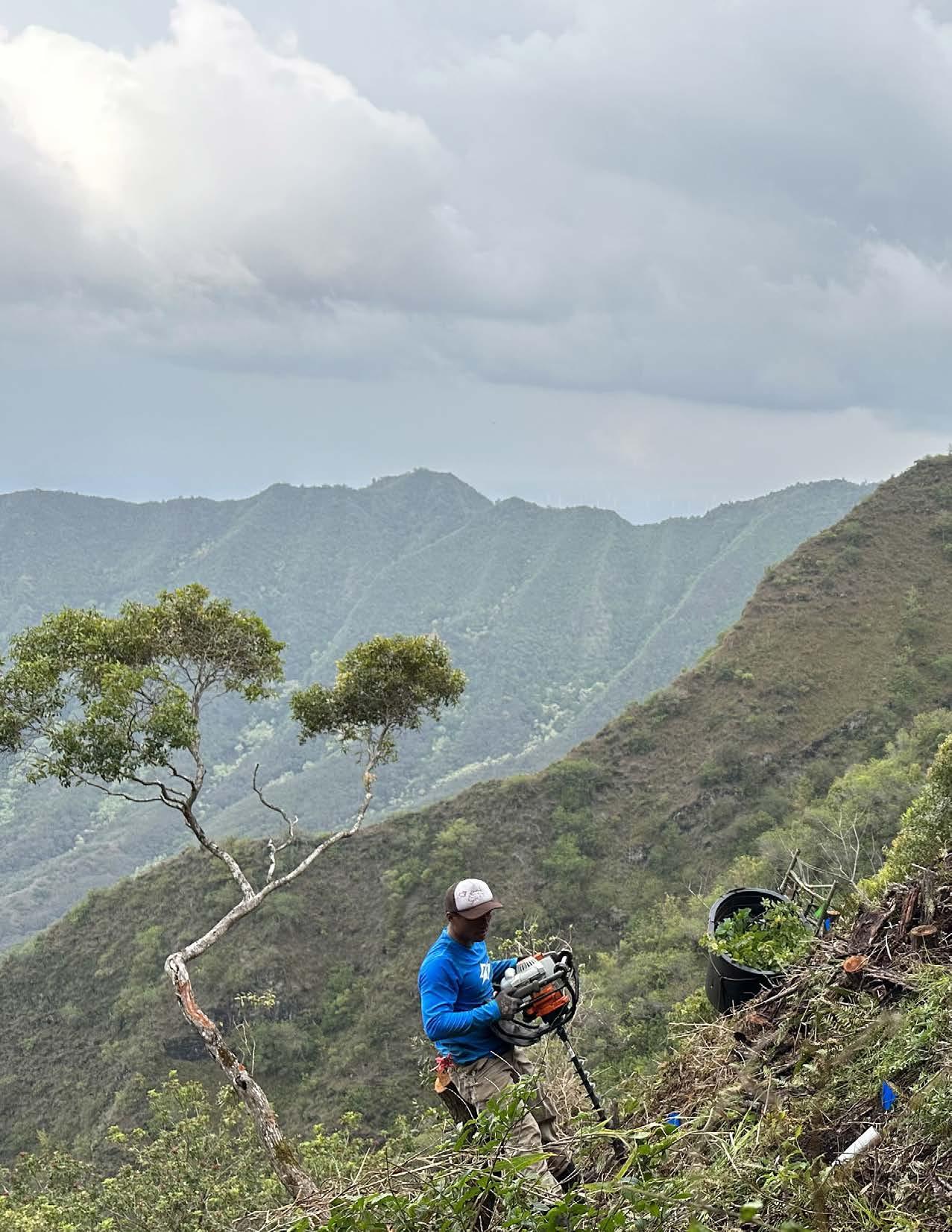
U.S. ARMY | EMP BULLETIN | 2022-2023 4
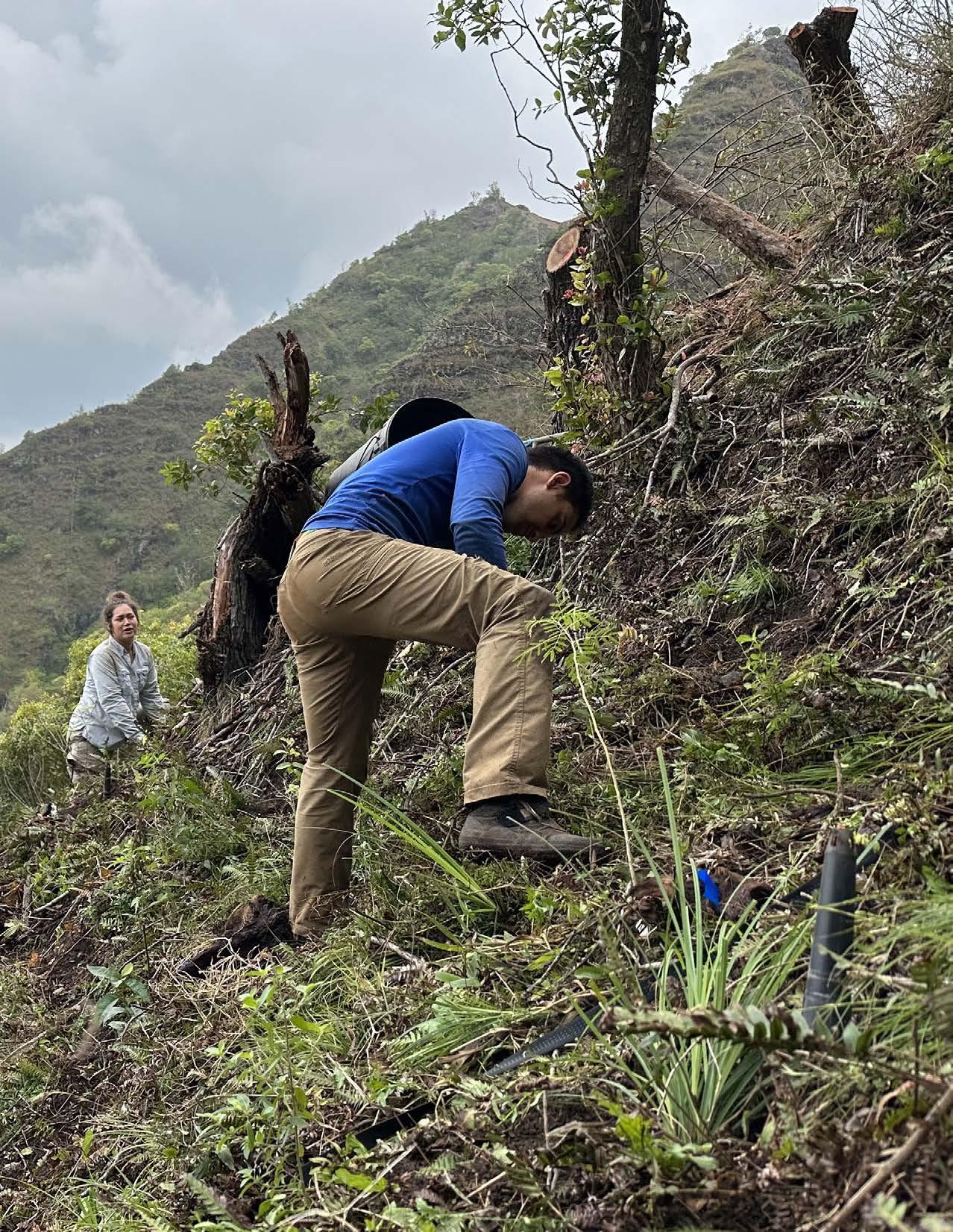
BACKGROUND

The beautiful curved hāhā flowers, illustrated by Tressa Hoppe. PRECEDING SPREAD Outplanting locations are chosen based on habitat requirements of the plants (north facing slopes, elevation, etc.) and ANRPO natural resource (NR) management technicians Aaron Pila (with auger) and Krista Lizardi, along with NR field team leader Keith Adams, are well adapted to working on steep terrain to boost populations of native Hawaiian plants in the wild.
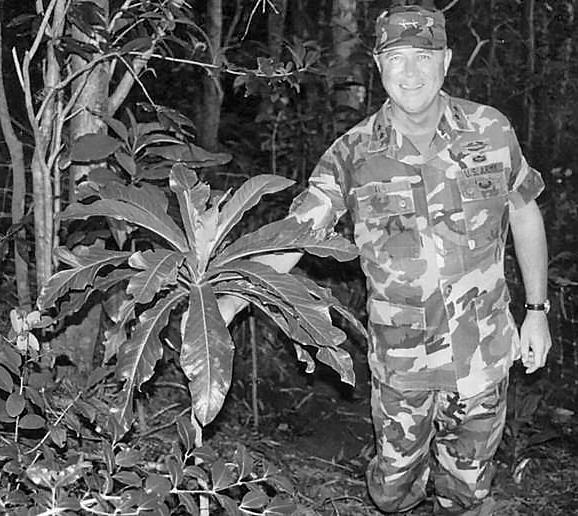 RIGHT U.S. Army Maj. Gen. James T. Hill with a Hawaiian hāhā, or Cyanea superba, ssp. superba—the first recorded endangered plant reintroduction by the Department of Defense in Hawai'i.
RIGHT U.S. Army Maj. Gen. James T. Hill with a Hawaiian hāhā, or Cyanea superba, ssp. superba—the first recorded endangered plant reintroduction by the Department of Defense in Hawai'i.
6 U.S. ARMY | EMP BULLETIN | 2022-2023
BRENNA KEEFE
25 Of Army rare plant conservation on O'ahu
years Reflections & next steps forward
 STORY BY KAPUA KAWELO & TIM CHAMBERS ILLUSTRATIONS BY TRESSA HOPPE
STORY BY KAPUA KAWELO & TIM CHAMBERS ILLUSTRATIONS BY TRESSA HOPPE
In the early 1990s members of the public and the U.S. Army began raising concern about the potential impacts of Army training activities on natural resources, especially threatened and endangered resources, on Army and adjacent lands. This concern led to action in 1993 when the Hawai'i Natural Heritage Program was contracted to initiate plant surveys on Army training areas. Survey efforts continued through 1998 and were essential in determining rare plant locations, population sizes, and to identify the multitude of current threats to endangered plants. This information would prove critical in the future Endangered Species Act consultations with the U.S. Fish and Wildlife Service and to determine and define management for rare plants.
A RARE PLANT FIELD PROGRAM IS BORN
In 1995 a four-person field team was established. This small but dedicated team continued to conduct plant surveys on Army training areas and also made active rare plant management possible. To protect rare plants from threats identified through survey efforts, the team began to construct fences around known rare plant populations and critical habitat to exclude pigs and goats, known destroyers of native Hawaiian plant communities. In 1998 the team conducted the first ever reintroduction of an endangered plant species by the Department of Defense in Hawai'i. With support from the installation commander Maj. Gen. James T. Hill, the hāhā
or Cyanea superba ssp. superba was restored in Kahanahāiki in the northern Wai'anae Mountains. Moreover, work began to establish genetic storage at Lyon Arboretum through seed banking and the storage of plant clones in tissue culture. These approaches safeguard rare plants outside of their natural habitat and provide plants for future reintroductions back into their natural contexts.
STABILIZATION DEFINED
The Mākua consultation with the U.S. Fish and Wildlife Service began in 1999 and continued until all training areas were covered. This process led to the establishment of the Mākua (2003) and the O'ahu (2008) Implementation plans. These two documents provided a necessary framework for rare plant management by defining stabilization goals for each species managed: a minimum number of populations; minimum number of mature plants in each population; stable demographic structure; threats to rare plants controlled; and collections—seeds or clones—secured in genetic storage. With this framework in place the Army Natural Resources Program, O'ahu (ANRPO) rapidly and aggressively expanded rare plant management in both the Wai'anae and Ko'olau mountain ranges and by 2009 the staff had expanded from four individuals to over 50 employees (including three teams of natural resource management technicians).

During this same period of growth, ANRPO management outpaced Lyon Arboretum’s capacity to store Army seeds in their seed bank and in response a seed conservation laboratory was established at Schofield Barracks in 2007, the first seed bank ever managed by the Department of Defense. In addition, two greenhouse facilities were constructed, one at Schofield Barracks and another at mid-elevation (2000 feet) on State land to produce rare plants for reintroduction and to maintain living collections for genetic storage. As rare plant management progressed, it became clear that expanded ecosystem restoration was necessary for future rare plant management efforts and in 2014 ANRPO established a new field team dedicated to vegetation and ecosystem restoration. Complementary to the establishment of this new field team, ANRPO initiated seed collections of common native plant species and expanded horticulture facilities and the production of plants in support of active restoration.
CURRENT STATUS
Today ANRPO intensely manages 39 rare plant species on and off Army lands and provides secondary management to an additional 54 species identified in the Integrated Natural Resources Management Plan (INRMP). To date the program has attempted 254 reintroductions of 36 species and has made over 16,895 observations of wild rare plants and 5,497 at rare plant reintroduction locations. Since 1998 ANRPO has produced over 31,000 rare plants for reintroduction into
8 U.S. ARMY | EMP BULLETIN | 2022-2023

9
Chris Wong, horticulture supervisor for ANRPO, checks on one of several thousand endangered native plants grown within the ANRPO rare plant nurseries at Schofield Barracks. ROY KIKUTA
RIGHT
FACING PAGE
Melicope sandwicensis is one of 44 native plant species that ANRPO identified as a Species at Risk (SAR) in Mākua Military Reservation.
 Natural resources (NR) field supervisor, David Hoppe-Cruz (right), collects empty dibble-tubes while Aaron Pila (left), an NR management field technician, helps to plant hundreds of native plants in the Wai'anae Mountains.
Natural resources (NR) field supervisor, David Hoppe-Cruz (right), collects empty dibble-tubes while Aaron Pila (left), an NR management field technician, helps to plant hundreds of native plants in the Wai'anae Mountains.
10 U.S. ARMY | EMP BULLETIN | 2022-2023
BRENNA KEEFE
16,895

Observations made by ANRPO staff of wild rare plants, in addition to 5,497 rare plant observations at introduction sites.
27
31,000
natural habitats and maintains 27 million seeds in the seed bank representing 215 species, 72 of which are endangered. Furthermore, living collections of 12 species are maintained in ANRPO greenhouse facilities and 26 living collections are managed at island botanic gardens.

Currently, ANRPO works to stabilize 51 plant taxa while other rare species on Army lands receive benefits from this management, as they exist in fences and rat trapping grids that are maintained by ANRPO staff. Yet, with more than 100 endangered plant species on Army lands, how does ANRPO ensure that other species in decline do not find themselves on the endangered species list?
SPECIES AT RISK

Identifying species on the path to being listed as endangered is critical to maintaining Army readiness. These species are called Species at Risk or SARs. It is important for the Army to understand the presence, distribution and extent of SARs and incorporate natural resource management to benefit these taxa into the Integrated Natural Resources Management Plans (INRMP). Beneficial management now for SARs may preclude the need for federal listing in the future.
For such a small bird (average weight 0.4 ounces and total body length of 5.9 inches) 'elepaio are extremely long-lived with the oldest confirmed to have survived to the age of 23 on O'ahu.
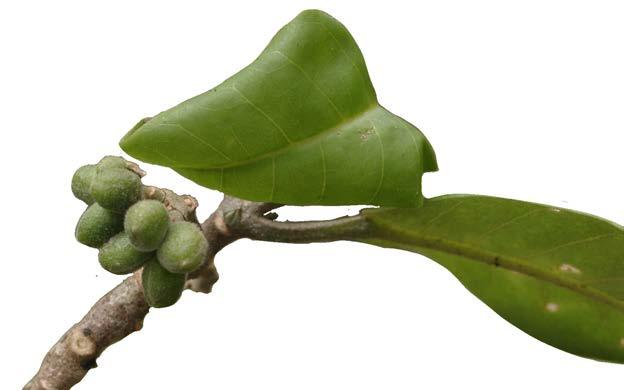
The Nature Serve program helped the Department of Defense identify which taxa qualify as SARs. Nature Serve assigns global rankings to each taxon based on available distribution and occurrence information. These global rankings can be found by searching for a taxon’s full scientific name using the NatureServe online database at https://explorer.natureserve.org.
Taxa are considered SARs if they are not yet federally listed under the Endangered Species Act and are categorized as critically imperiled (G1/T1 or G2/T2), or if they are birds and regarded as vulnerable (G3), or if they have an International Union for the Conservation of Nature (IUCN) status of Critically Endangered (CR), Endangered (EN), Vulnerable (VU) or Near Threatened (NT).
In 2021 the Army’s Natural Resources Program at Pohakuloa
Rare plants produced by ANRPO staff for reintroduction into native habitats.
million Seeds in the ANRPO seed bank.
Melicope sandwicensis
conducted an analysis of plants and animals which qualify as SARs and in 2022, the Army’s Natural Resources Program on O'ahu conducted a SAR analysis for taxa known from Army land on O'ahu. In order to complement the NatureServe database rankings, this analysis also incorporated the International Union for the Conservation of Nature (IUCN) rankings, the State of Hawai'i Department of Land and Natural Resources wildlife fact sheets and expert opinion and observation information.
DETERMINING SARS ON O'AHU ARMY TRAINING AREAS
To begin, ANRPO created a native plant species list for Army lands. Species presence information was pulled from the Army’s rare plant tracking and vegetation monitoring databases. In addition, these lists were cross-checked with historical survey data. Taxa information such as federal status, NatureServe global ranking, IUCN ranking, distribution information and notes was tracked and recorded. Taxa with federal status were filtered out and the remaining taxa were sorted for G1/T1 and/or G2/ T2 ranks. This resulting list provided the plant SARs found on Army training lands. This list also identifies the training areas where each taxa occurs, so that SAR lists can be generated for each training area.
A grand total of 97 total plant SARs known on O'ahu Army training lands were identified, many occuring on more than one training area. Thirteen of these are ranked G1 or T1. By training range, there are 44 SAR plants found at Mākua Military Reservation (MMR), 50 at Schofield Barracks West Range in the Wai'anae Mountains (SBW), 35 from Schofield Barracks East Range in the Ko'olau Mountains (SBE), 52 from the Kawailoa Training Area (KLOA), five from Dillingham Military Reservation (DMR) and 29 found at Kahuku Training Area (KTA). Of these, IUCN ranks two taxa as Critically Endangered (CE), 13 as Endangered (EN), 21 as Vulnerable (VU) and five as Near Threatened (NT).
HOW WILL THIS NEW INFORMATION BE USED?
With a full plate of work to do already, it will be challenging for ANRPO botanists to take on more tasks. To help prioritize field actions, ANRPO plans to concentrate efforts on the SARS taxa that require immediate attention. For example, one SAR plant, Melicope kaalaensis is endemic to the Wai'anae Mountains and there may be as few as 50 individuals
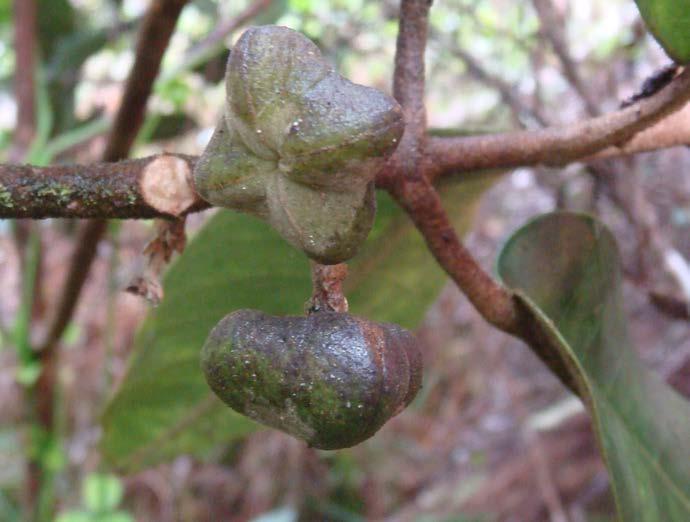
remaining in the wild. This plant occurs within the 'Ohikilolo Management Unit (MU) on Army lands and is already protected from goat browsing within the ungulate free MU fence unit. Likewise, the M. kaalaensis fruit are already protected from rat predation because it occurs within the ANRPO 'Ohikilolo rat control grid designed to protect other endangered species including a native palm, Prichardia kaalae, and Achatinella mustelina, or kāhuli tree snails. Lastly, it benefits from ongoing ecosystemlevel ANRPO weed control efforts at 'Ohikilolo. The only missing piece for this rare plant is species-level management such as fruit collection, propagation and outplanting. The SAR analysis allows ANRPO to identify these low-hanging fruit (pun intended) where a large impact can be made with minimal new input. Other SARs on 'Ohikilolo that benefit from ongoing ecosystem level management include, the rare plant Schiedea mannii, a rare insect, Rhyncogonus fordi, and a rare snail, Succinea cinnamomea. Preliminary analyses have been conducted for insects and snails but available information on species status is limited for these groups of organisms.
As new information becomes available, ANRPO will continue to update the SAR list for O'ahu. In the meantime, field teams are making more of an effort to track the locations of SARs while they are conducting other work in order to understand the extent of some of these lesser-known taxa on Army training lands.
12 U.S. ARMY | EMP BULLETIN | 2022-2023

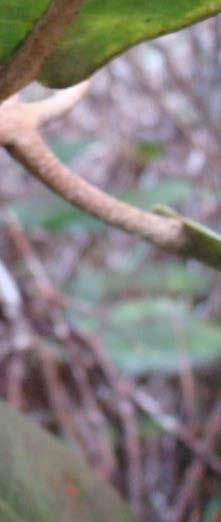
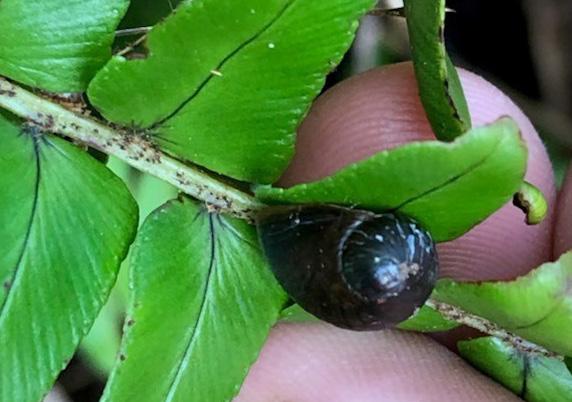
13
CLOCKWISE FROM TOP Schidea mannii, Succinea cinnamomea and Melicope kaalaensis—Species at Risk (SAR) protected within the ANRPO 'Ōhikilolo management unit on O'ahu.
A new species of Pamakani to Receive Scientific Recognition
STORY BY LENA SCHNELL
ILLUSTRATIONS BY TRACY WAGER

14 U.S. ARMY | EMP BULLETIN | 2022-2023
Tetramolopium
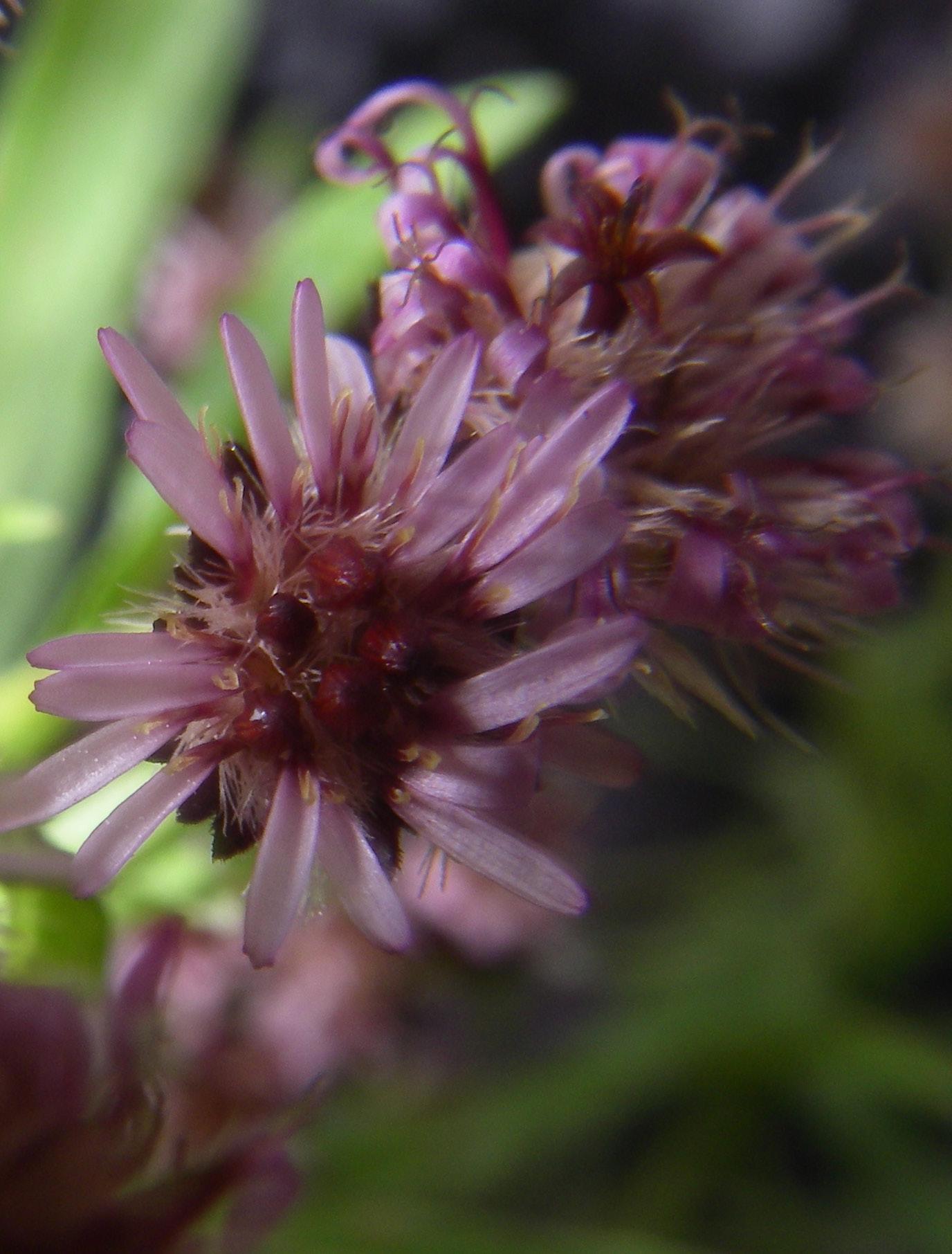

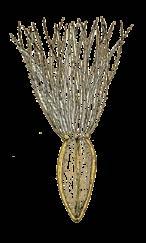


15
Table 1: Status of Hawaiian pamakani species.



Red indicates species listed as threatened or endangered at the species level so that all subspecies and varieties are also included in the listing status. Candidate Status: 1= evidence supports listing taxa, but no rule proposed, 1*= taxa may be extinct, 2= taxa may require listing, but evidence is lacking, and 3A = Not a candidate for listing, taxa likely extinct.

Tetramolopium species Status in 1975 Listing Petition Candidate Status (Listing Year) 2022 ESA Status (Listing Year) Location 1* (1985) 3A (1990) T. arenarium subsp. arenarium var. confertum Extinct Listed at species level (see above) Not Listed Extinct T. arenarium subsp. laxum Extinct Listed at species level (see above) Not Listed Extinct T.capillare Extinct 1* (1985)Endangered (1994) Maui 1 (1985) 3A (1990) Removed (1996) T.consanguineum subsp. leptophyllum var. kauense Extinct Not Listed Not Listed Hawai'i (Ka'ū) 1 (1985) 2 (1990) Removed (1996) 1* (1985) Removed (1993) T. filiforme var. filiforme Extinct 1 (1985) Endangered (1991) O'ahu T. filiforme var. polyphyllum Endangered 1 (1985) Endangered (1991) O'ahu T.humile subsp. Haleakalae Not listedNot Listed Not Listed Maui T.humile subsp. humile var. humile Not listedNot Listed Not Listed Hawai'i (PTA) 1 (1985) 2 (1993) 1* (1985) (removed 1993) T.lepidotum subsp. lepidotum Endangered 1 (1985) Endangered (1991) O'ahuWai'anae T.remyi Extinct 1 (1985) Endangered (1991) Maui Nui T. rockii var. calcisabulorum Extinct 1 (1985) Threatened (1992) Maui Nui (Moloka'i) T. species 1 Not ListedNot Listed Not Listed Hawai'i (PTA) T.sylvae Not Listed Not Listed Not Listed Maui Nui 1* (Removed 1993) T.lepidotum subsp. arbusculum Extinct Not Listed Likely Extinct Removed (1996) T.humile subsp. humile var. sublaeve Extinct Not Listed Hawai'i (PTA) T.tenerrimum Extinct Not Listed Likely Extinct T. rockii var. rockii Extinct 1 (1985) Threatened (1992) Maui Nui (Moloka'i) T.consanguineum subsp. leptophyllum var. leptophyllum Extinct Not Listed Hawai'i (PTA) T.conyzoides Extinct Not Listed Possibly found on Hawai'i at PTA in 1986 T.arenarium subsp. arenarium var. arenarium Extinct Endangered (1994) Hawai'i (PTA) T.consanguineum subsp. consanguineum Extinct Not Listed Kaua'i – Likely Extinct
16 U.S. ARMY | EMP BULLETIN | 2022-2023
Three decades after discovery at Pohakuloa Training Area (PTA), an undescribed species of pamakani, a daisy-like plant in the genus Tetramolopium, is on the verge of receiving scientific recognition and a new name. The discovery of a species new to science and the journey to describe and name this new Tetramolopium species, referred to as T. species 1, intertwines with the taxonomic complexities of the genus and the discovery of the rich botanical resources found at PTA. To receive scientific recognition, a description of the new species must be published in a peer-reviewed, reputable scientific journal. A manuscript describing T. species 1 was submitted to the journal of Systematic Botany and pending revisions, is expected to be published in 2023 when the new, official name of the species can be revealed. Recognizing and naming this new species will help the U.S. Army Garrison Pohakuloa Training Area (USAG PTA) Natural Resources staff to track and conserve this critically rare species.
Pamakani – A chance immigrant to Hawai'i
A single ancestral species of pamakani likely dispersed to Hawai'i on wind currents from Australia via New Guinea. This ancestral species then evolved into 11 endemic species including eight subspecies, and 10 varieties. With the addition of the Hawai'i Island-endemic T. species 1, there will be 12 species of pamakani in Hawai'i.
Pamakani are short-lived shrubs that belong to the sunflower family. Some species are small, only growing a few inches tall. Other species grow up to six feet in height with foliage and flowers clustered at the tips of the branches. Pamakani have small, daisy-like flowers that range from white, to yellow, to purple. At PTA, pamakani grow in native forests on 'a'ā lava or soil deposits.
Species of pamakani have likely always been rare in Hawai'i. In 1974, seven pamakani species and two subspecies were thought to be extinct, and two species were recommended for listing as endangered under the Endangered Species Act (ESA). Expanded botanical surveys across the islands in the late 1980s and early 1990s rediscovered several pamakani species that were thought to be extinct. Today, six of these 11 pamakani species are listed as threatened or endangered, two are still thought to be extinct, and only T consanguineum, T humile and T sylvae are considered common (Table 1).
Pamakani at Pohakuloa Training Area
The remote ecosystems of PTA remained relatively undocumented until 1977 when biologists inventoried the region and found several rare plants including two species of pamakani listed as extinct in 1974: T. consanguineum var. leptophyllum and T. humile var. sublaeve. In 1976 the U.S. Fish and Wildlife Service proposed these species for listing
as endangered under the ESA. Biologists continued to find new locations of these species and by 1996 the species were no longer candidates for listing under the ESA based on their widespread abundance.
Discoveries of a new pamakani species
Tetramolopium species 1
Botanical surveys continued at PTA through the 1980s. While surveying southwestern PTA in 1989, biologists discovered the first instance of the distinctive pamakani that would later prove to be new to science—T. species 1.
 ABOVE AND PRECEDING SPREAD Variations of mature Tetramolopium species 1, an undescribed pamakani species at Pōhakuloa Training Area (PTA), soon to be renamed.
ABOVE AND PRECEDING SPREAD Variations of mature Tetramolopium species 1, an undescribed pamakani species at Pōhakuloa Training Area (PTA), soon to be renamed.
17

18 U.S. ARMY | EMP BULLETIN | 2022-2023
The first population of T. species 1 was found in a native shrub community dominated by māmane (Sophora chrysophylla) and naio (Myoporum sandwicense) trees. There were 69 live plants (31 seedlings, 27 juveniles, and 11 mature/reproductive). The population was fenced soon after discovery to protect it from feral ungulates (sheep, goats, and pigs). This population persisted until about 2012 but plants are no longer present within this fence.
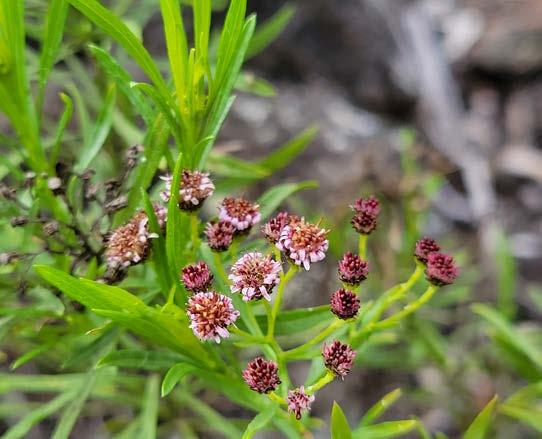
Biologists next encountered T. species 1 in 1993, when they discovered about 300 plants in western PTA. Between 1993 and 1997, biologists found another five groupings of T. species 1 in western PTA. By the year 2000, plants remained at only two of the six groups in western PTA. The two sites were fenced in 2004 and plants are still present today.
Between 2011 and 2020, biologists found another six new groupings of T. species 1: four in southwestern PTA and two in western PTA. As of December 2022, T. species 1 occupied seven locations, four in southwestern PTA and three in western PTA and there were 83 adult/juvenile plants and 188 seedlings at all sites combined.
Rediscovery of Mauna Kea Pamakani
Tetramolopium arenarium var. arenarium
During floristic surveys from 1989-1990, surveyors also rediscovered Mauna Kea pamakani (T. arenarium var. arenarium), which was listed as possibly extinct in 1974. This population was found in western PTA and comprised 134 adults with few young plants. Since its rediscovery, the entire world-wide population of Mauna Kea pamakani is limited to a few square kilometers in western PTA. In 1994, the Mauna Kea pamakani (including all subspecies and varieties) was listed as endangered. USAG PTA Natural Resources Program staff works to reduce threats to this critically endangered pamakani including drought, wildfire, invasive plants, and invasive animals including ants, aphids, and scale. As of December 2022, there were 93 adult/ juvenile plants and 37 seedlings.
Other unidentified pamakani species found at PTA
In 1996, biologists found yet another undescribed Tetramolopium in western PTA. They found two flowering plants and nine young plants and tentatively identified them as T. conyzoides or T. arenarium var. laxum, or perhaps another undescribed taxon. Although they took leaf samples and photographs, a positive identification was never made. The biologists were careful to state that this undescribed species was different from T. species 1. The
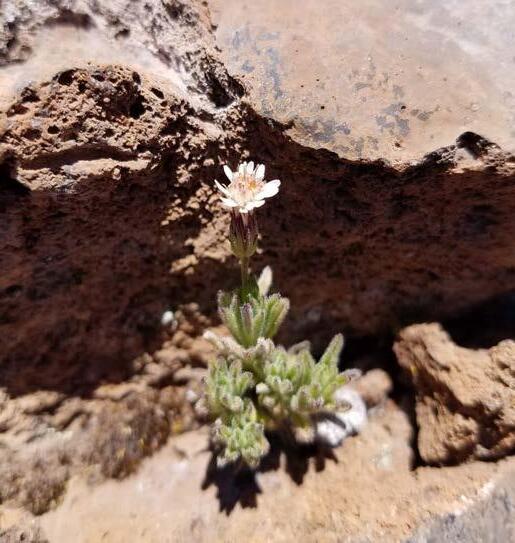
Tetramolopium consanguineum, subsp. leptophylum, var. leptophylum (TOP) and Tetramolopium humile, subsp. humile, var. humile (ABOVE) have both been found at Pōhakaloa Training Area (PTA) on Hawai'i island but are currently not listed as endangered.
PAGE David Cole, botanical program manager with Center for Environmental Management of Military Lands (CEMML), monitors Tetramolopium species 1 at Training Area 23 at PTA.
location of the 1996 find is about 2.5 kilometers from where another undescribed Tetramolopium, tentatively identified by Bishop Museum as T. conyzoides, was discovered in 2019. Unfortunately, that single individual died before it flowered and could be positively identified. Leaf tissue was collected while the individual was alive and is awaiting genetic analysis. USAG PTA Natural Resources Program staff surveyed the area in 2022, but no additional plants were located.
Most recently, in 2021 USAG PTA Natural Resources Program staff found a pamakani species in southwestern
19
FACING
LENA SCHNELL
An endangered Tetramolopium arenarium, subsp. arenarium, var. arenarium (TOP) and an unidentified Tetramolopium species (BOTTOM), possibly related to T. humile, found by Army natural resources staff at Pōhakaloa Training Area (PTA) on Hawai'i island.LENA SCHNELL. FACING PAGE Current and previous locations of Tetramolopium species 1 at PTA.

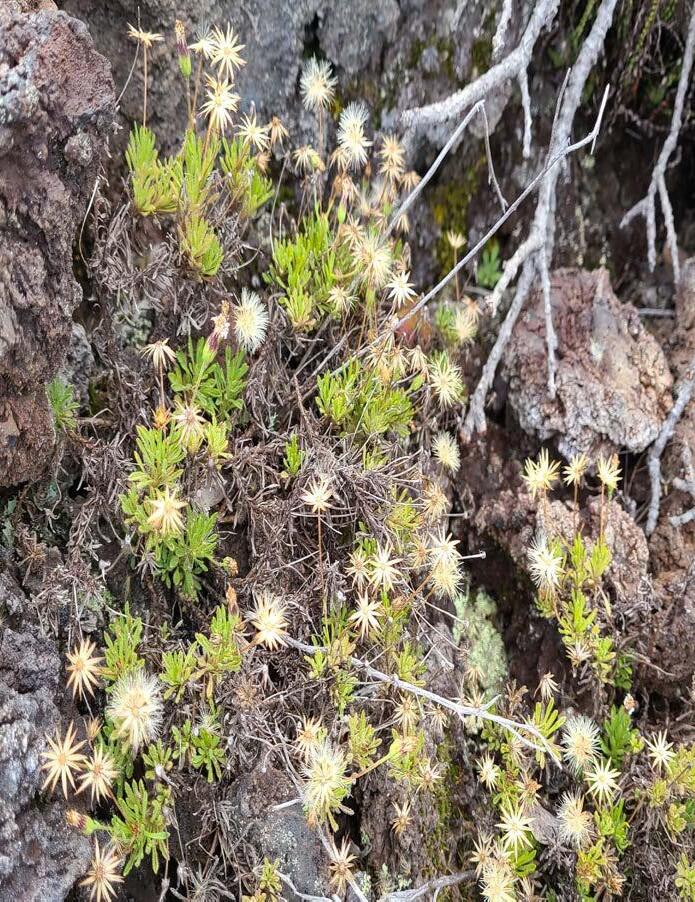

20 U.S. ARMY | EMP BULLETIN | 2022-2023
PROTECTION
SW group is fenced to prevent damage from troop movements and feral ungulates (sheep, goats, pigs)
DISCOVERY
T. species 1 discovered in southwestern (SW) PTA
PROTECTION/ LOSS
Fenced two groups in western PTA with remaining plants (plants were gone from the four other group locations)
Tetramolopium species 1 Timeline
LOSS

Plants in the SW group discovered in 1986 die-out
All feral ungulates removed from large-scale fence units
DISCOVERY
Six new groups of T. species 1 discovered in western PTA

PROTECTION
Construction of large-scale conservation fences at PTA to protect 37,290 acres of dry forest habitat
DISCOVERY
Five new groupings discovered: three in SW PTA and two in western PTA
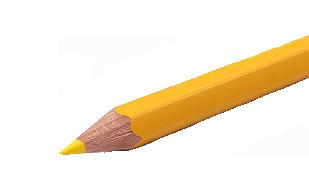
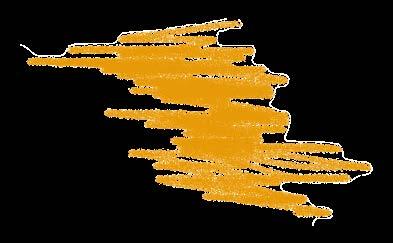
MONITORING
One new group of T. species 1 discovered in SW PTA — Monitoring totals: Seven groups (including 3 in SW PTA & 2 in western PTA).Total of 174 adults/ juvenile plants; 106 seedlings
PTA, that resembles T. humile but appears to be a distinct taxon. The plants were found growing on 'a'ā lava in 'ohi'a (Metrosideros polymorpha) forests. Samples of flowering adults will be collected and sent to the Bishop Museum for identification.
Taxonomic considerations for Tetramolopium species 1
In 1994, the undescribed pamakani species, T. species 1, was tentatively identified as T. lepidotum by Dr. Timothy Lowery.
However, by 1996, this name was rejected based on dissimilar physical characteristics between the two species. In 1997, Dr. Robert Shaw informally referred to the species as T. diersingii in a technical report, Rare Plants of Pohakuloa Training Area, but never published a valid description of the species in a peer-reviewed, scientific journal.
There was still uncertainty as to whether T. species 1 was a new species. The process to name a species requires a detailed description of the characteristics—physical and genetic—that set the species apart from its relatives before
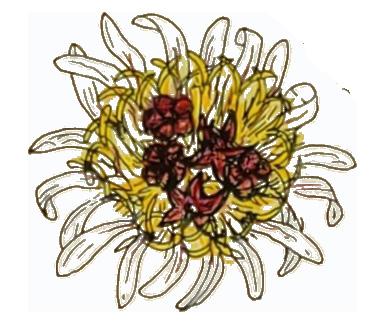
1989 1991 1993 to 1997 2004 2006 to 2010 2012 2013 to 2015 2017 2020
21
it can be published in a scientifically reputable journal. To clarify if T. species 1 was indeed a new species, leaves of T. species 1, T. arenarium, and T. consanguineum were sent for genetic testing in 2015. Results confirmed that T. species 1 is a distinct species. However, it was not until 2020 that a resolute effort was made to collect samples and measure key physical floral characteristics, needed to develop an accurate, acceptable description of the attributes that define T. species 1. These physical and genetic characteristics, along with an updated technical drawing of the species detailing these key characteristics, are presented in the manuscript submitted to the journal Systematic Botany
As part of the process to name a species, five type specimens were collected from PTA and will be deposited at Bishop Museum Herbarium, U.S. National Herbarium at the Smithsonian Institution, Colorado State University Center for Environmental Management of Military Lands Herbarium at Colorado State University, and PTA. These type specimens will help researchers and biologists identify this new species. Lastly, the proposed name for T. species 1 will honor the late Dr. Ruth Leilani “Lani” Stemmermann, who was steadfast in her protection of the unique fauna, flora, and ecosystems of Hawai'i by incorporating her family name into the specific epithet.
Tetramolopium species 1 status and management


In 2013 construction of large-scale fence units encompassing over 37,290 acres was completed at PTA. Feral goats, sheep, and pigs were removed from the fences by 2017. These fences encompass all known locations of T. species 1 and T. arenarium and large portions of the distributions of T. consanguineum and T. humile at PTA.
Today, the USAG PTA Natural Resources Program manages seven groupings of T. species 1 distributed between southwestern and western PTA. To manage threats, staff implement landscape-level projects to reduce wildland fire risk and to keep the fence units ungulate-free. They also actively conserve T. species 1 genetics by collecting seeds. The seed bank at USAG PTA contains 19,316 seeds from the natural population and 165,335 seeds from individuals grown in the USAG PTA Rare Plant Propagation Facility or from outplanted individuals.
To date, staff have outplanted a total of 357 T. species 1 plants on and off the installation. However, T. species 1 has only established a self-sustaining population at one location in southwestern PTA in habitat similar to wild populations. In December 2022, there were 171 adults/juveniles and 32 seedlings at the outplanting site. This site has been extremely successful for this species since 2012 and numbers at this outplanting site are often higher than the wild population.
Although T. species 1 is limited in distribution and abundance, its status as a species will finally be established when the manuscript is published. With T. species 1 recognized as a species, land managers can more effectively seek funding for the management of this rare species, thereby growing the Army’s understanding and ability to protect these unique pamakani at PTA and beyond.
22 U.S. ARMY | EMP BULLETIN | 2022-2023
ABOVE The diminutive size of the endangered T. species 1 flowers can make monitoring challenging, but rewarding to find and photographJESSICA KIRKPATRICK. RIGHT Hand-colored technical drawing of Tetramolopium species 1 by Tracy Wager, technical illustrator with Center for Environmental Management of Military Lands (CEMML), Colorado State University.
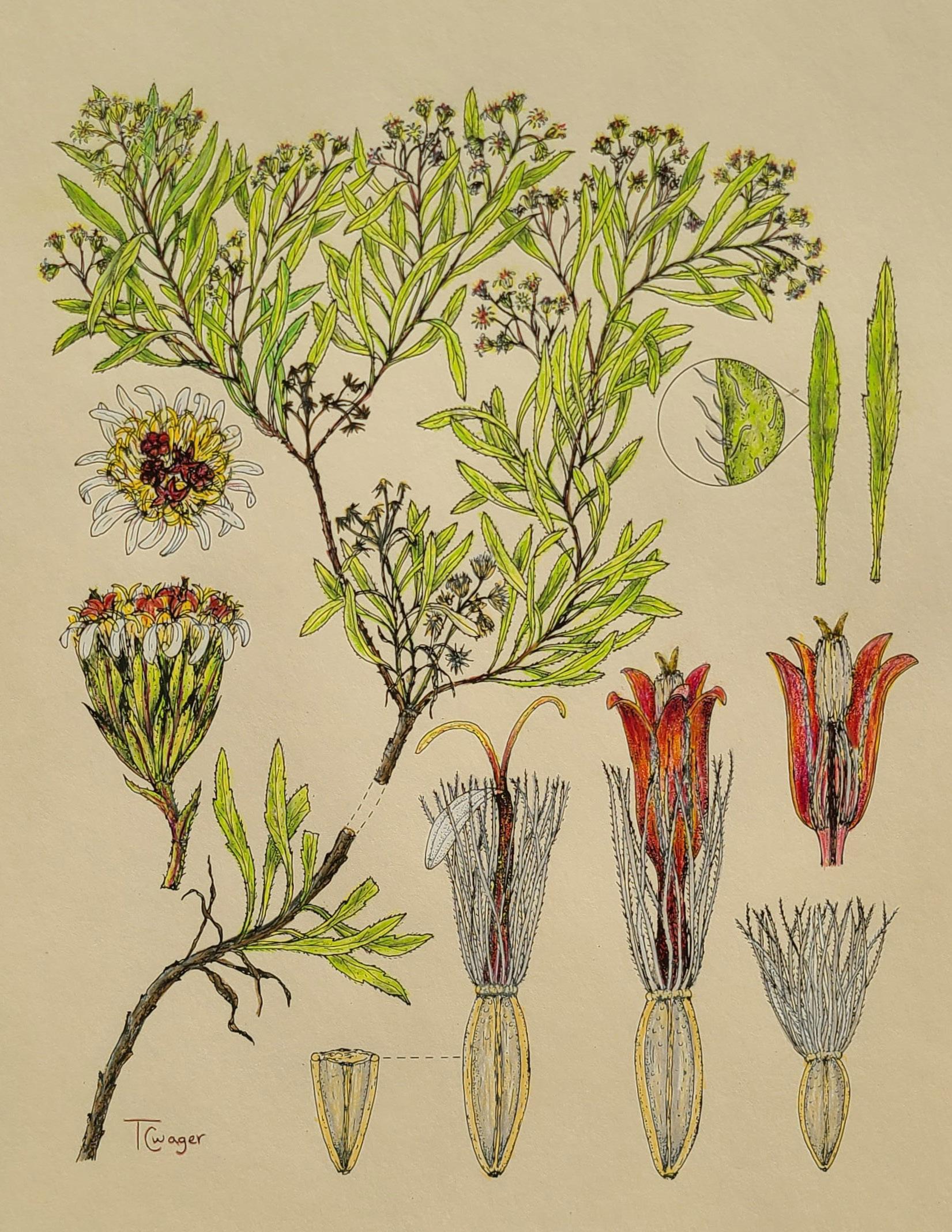

24 U.S. ARMY | EMP BULLETIN | 2022-2023
TEndang E r E d o'ahu Lou L u u nd E r Thr E a by Co C onu T r hino CE ros bEET
STORY BY JESSICA ADINOLFI
Have you noticed these black things suspended from tree branches around O'ahu? Maybe it was apparent right away they are traps – but for what, one may wonder. These black and white ornaments are panel traps for detecting an invasive pest, the coconut rhinoceros beetle (Oryctes rhinoceros). In November 2013 the first coconut rhinoceros beetle, or CRB for short, was identified on O'ahu – the first and only Hawaiian island known to have this pest.

WHAT ARE THEY, WHERE ARE THEY FROM, AND HOW DID THEY GET HERE?
CRB is a large reddish black beetle with a horn on its head. Males typically have longer horns than females. Adult beetles are two inches long on average, and the larvae can be up to 4 inches before pupating! As the name suggests, they primarily attack coconut palms or niu (Cocos nucifera), but they have been found to feed on and damage many other plants. Adult CRB feed mostly on the sap at the crown of palms. The CRB eggs and larvae develop in mulch and decomposing plant material.

CRB are native to regions of South and Southeast Asia from Pakistan to the Philippines and were accidentally introduced to several South Pacific islands. In September 2007, it was determined CRB had infested Guam, and an eradication program was established.
The first CRB detected on O'ahu was found in the international arrivals baggage claim area at the Honolulu Airport. While most people thought it was an isolated incident, traps were deployed, and a trap hit on Dec. 23, 2013, in Māmala Bay. Since CRB’s introduction, they have continued to spread, leaving a wake of damaged and dead
ELFACING PAGE Ka'ala loulu (Pritchardia kaalae), an endangered palm endemic to the Wai'anae mountain range of O'ahu, is susceptible to coconut rhinoceros beetle (CRB) damage. To help boost wild Ka'ala loulu populations, Army Natural Resources Program staff use mesh bags to collect fruit for propagation and reintroduction of this loulu back into the wild. ABOVE TOP A mature invasive CRB (Oryctes rhinoceros) WWW.CRBHAWAII.ORG ABOVE A CRB Panel Trap, designed to lure and trap mature CRBs.
25
trees. Recently it was reported trap detections are now over 40,000 CRB on O'ahu. Currently, they occur in large numbers near Pearl Harbor, central O'ahu, and western O'ahu. Recent infestations have been found in the North Shore and northern windward side. Eastern O'ahu, from the airport on the south coast to Punalu'u on the windward coast, remains mostly uninfested.
MORE THAN JUST COCONUTS
The CRB is one of the most damaging insects to coconut palms, their preferred host. In addition to being a major pest to coconut palms, they are also devastating to fan palms, royal palms, date palms, and foxtail palms. When their preferred food source is not around, they will feed on other plants, including hala, kalo, sugarcane, and pineapple. CRB damage to trees and crops has economic, agricultural, cultural, and ecological implications.
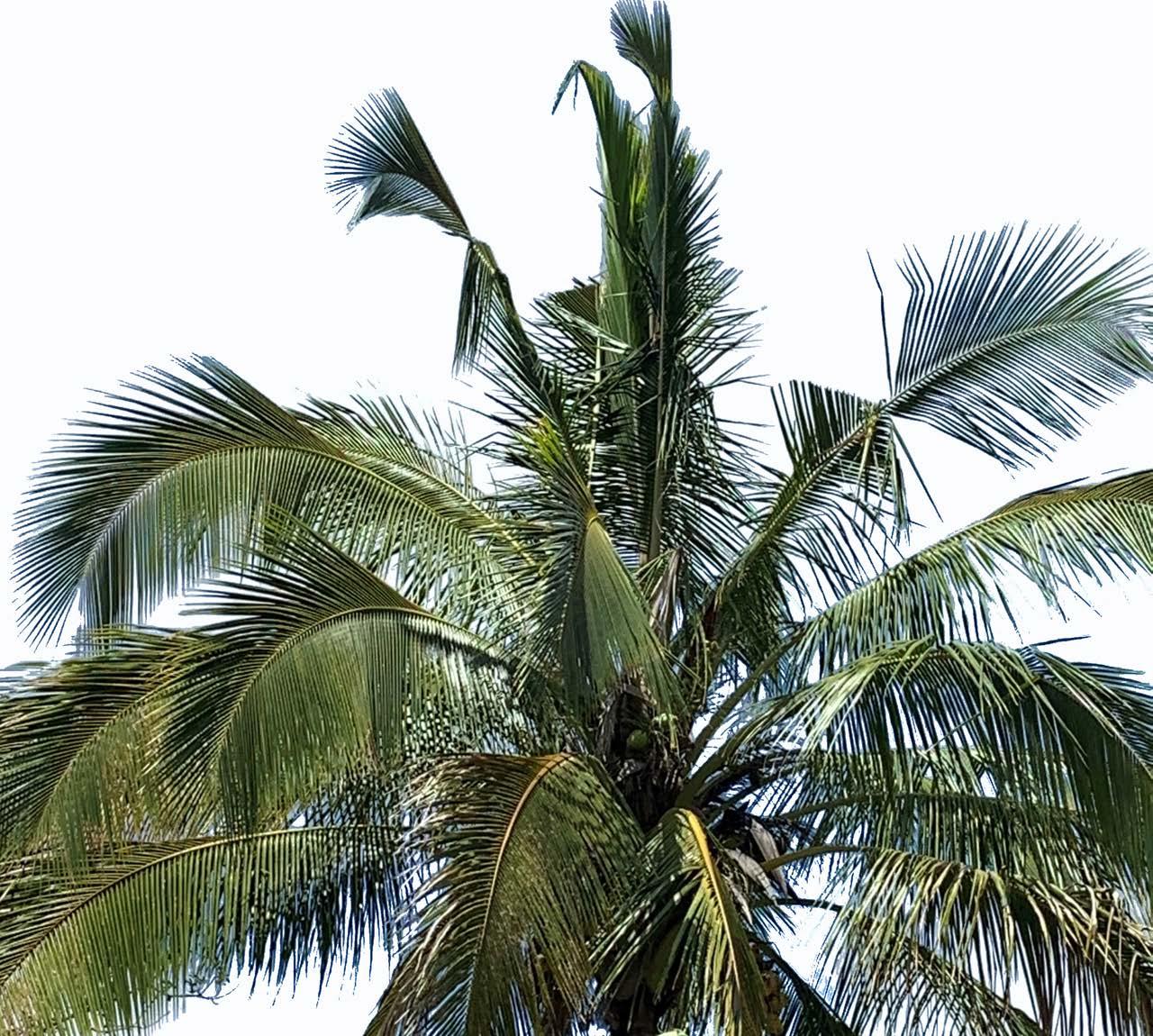
CALL CRB RESPONSE
In 2014, the U.S. Department of Agriculture (USDA) Animal and Plant Health Inspection Service (APHIS), the Hawaii Department of Agriculture (HDOA), the University of Hawai'i (UH), and the Joint Base Pearl Harbor-Hickam (JBPHH) came together to develop the CRB Response team. The CRB Response is still leading the fight against CRB, educating people, professionals, and organizations about the threat, spread, and what can be done to minimize spread and damage from CRB.
U.S. Army Garrison Hawai'i has been working with CRB Response to deploy and check traps, understand how to treat affected trees, and implement best management practices to minimize the spread of CRB—including developing a Green Waste Policy to comply with an interim rule.
In July 2022, HDOA approved the Plant Quarantine Interim Rule 21-1, which prohibits the intra- and inter-island movement of CRB host material,
FACING PAGE A coconut palm at Schofield Barracks with telltale signs of CRB damage after CRBs chew through developing leaves at the crown of the tree, they unfurl with 45-degree-angled "v-cuts." LEFT CRB Response staff demonstrate how to perform pesticide injections to CRB damaged palm trees, a technique used to treat trees damaged by CRBs. BELOW The CRB larvae can grow up to 4 inches before they pupate into their adult form. WWW.CRBHAWAII.ORG
BOTTOM The CRB Response team includes several trained dogs, including Rider, who was able to detect CRB breeding in a mulch pile at Schofield Barracks.

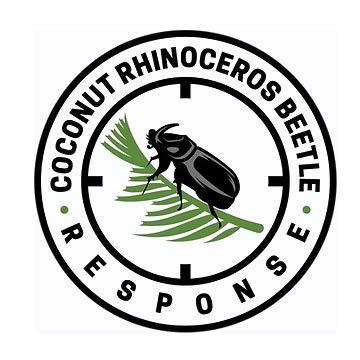


27
including green waste and live palm trees, within the island of O'ahu, to and from the island of O'ahu, and other areas known to be infested with CRB to un-infested islands in the state except by a compliance agreement issued by HDOA.
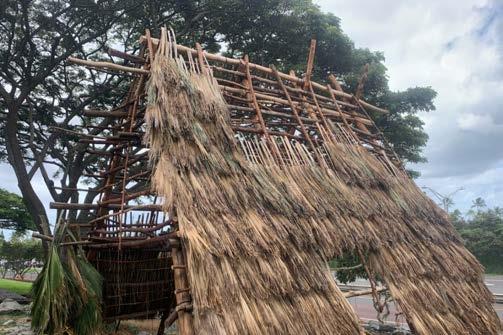
COCONUT RHINOCEROS BEETLES AND LOULU
The Army’s Natural Resources Program on O'ahu (ANRPO) manages many threatened and endangered species, one of which is a small fan palm susceptible to CRB. Ka'ala loulu (Pritchardia kaalae) is endemic to the northern Wai'anae Mountains on O'ahu, where it grows on steep slopes in mesic to dry forest. There are around just 300 mature Ka'ala loulu left in the wild. Unfortunately, evidence of CRB damage, including plant death, has already been observed on Ka'ala loulu in gardens. While no damage has been found on wild Ka'ala loulu to date, CRB have been found in panel traps as close as a half mile away. The survival of this entire species is in jeopardy.
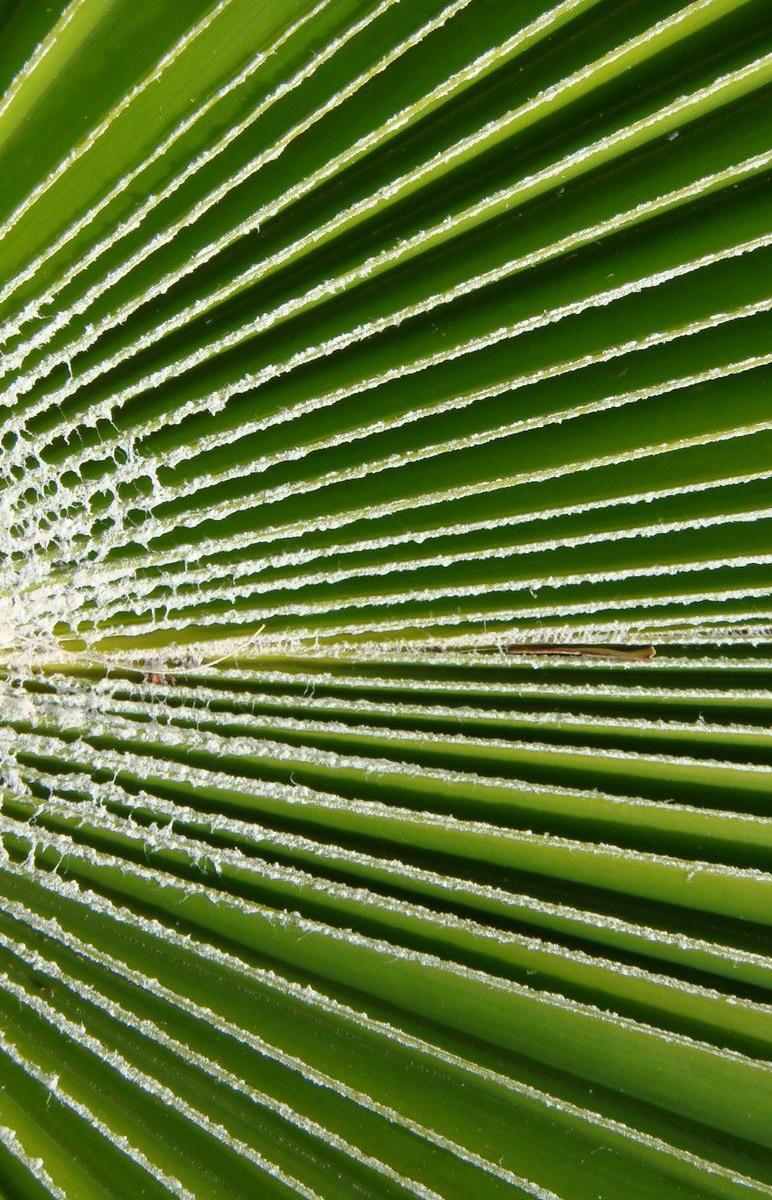
The name loulu refers to all of the Hawaiian Pritchardia species and in fact, all but three species of Pritchardia in the world are native to Hawai'i. In total, there are 24 native loulu species found across the Hawaiian Islands. Besides the Ka'ala loulu, O'ahu is home to four other loulu species, one farily common and three very rare, all found on the Ko'olau Mountains. While O'ahu species face the most immediate threat from CRB, all Hawaiian loulu could be devastated by CRB if it spreads through the island chain. loulu leaves were traditionally used for thatching and weaving, while immature fruit, or hawane, which have a similar taste to coconut, were eaten.
endangered species was rosy, until CRB came on the scene. Staff are taking steps to protect Ka'ala loulu from this new threat. This involves a lot of collaboration with partners, including CRB Response, the Department of Land and Natural Resources, the Plant Extinction Prevention Program, the U.S. Fish and Wildlife Service, Lyon Arboretum and other UH researchers, among others. Efforts include monitoring wild trees for damage, checking panel traps in remote areas as an early detection measure, conducting novel research to figure out the best way to store loulu seeds, and supporting researchers studying CRB habitat needs and potential biocontrol options.
WHAT CAN WE DO TO HELP?
While the story of CRB on O'ahu may seem to have a not-sohappy ending, there are some things we can do to help. The main priority at this point is to contain CRB and not allow it to spread to the other Hawaiian islands or other locations with suitable habitat and hosts plants on O'ahu.
HELP MINIMIZE THE SPREAD OF CRB:
1 2 3 4
Don't transport compost, mulch, soil, or palm trees to other islands or from infested areas to uninfested areas on O'ahu.
Check suitable host trees for signs of CRB damage and report to the CRB Response program.
If suspected CRB are found, contain the beetle in a glass container and contact the CRB Response program.
When applying mulch, spread it as thinly as possible (less than 2 inches is recommended). CRB have been known to breed in any depth of mulch and prefer older, decomposing material over fresh green waste.
ANRPO staff have been managing Ka'ala loulu for more than 20 years. While the trees are long-lived, no keiki (immature plants) were seen until staff began controlling rats, which destroy fruit, and goats, which eat seedlings. Today, hundreds of young plants thrive in wild populations. In addition, outplantings of Ka'ala loulu are healthy and vigorous and beginning to set seed. The prognosis for this
5 6
When hiring landscaping professionals, select a business listed on the Compliant Business List on the CRB Response website.
Educate yourself about CRB on the CRB Response website: www.crbhawaii.org and spread the word to your family, friends, and neighbors.
28 U.S. ARMY | EMP BULLETIN | 2022-2023
A traditional Hawaiian hale with native loulu (Pritchardia sp.) thatching. HI'ILEI KAWELO
Army Natural Resources Program, O'ahu (ANRPO) staff outplant endangered Ka'ala loulu (Pritchardia kaalae) within a management unit that is fenced to keep out goats and pigs, on the Wai'anae mountain range.

Readiness and Environmental Protection Integration
The Department of Defense (DOD) plays a key role at the intersection of national security and conservation, which is where DOD’s Readiness and Environmental Protection Integration (REPI) Program functions as a vital tool. The REPI Program fosters multi-agency initiatives and collaboration through cost-sharing partnerships to bolster local and regional conservation of natural resources and open space, while simultaneously preserving compatible land uses near military installations and ranges.
What has the REPI Program brought to Hawai'i?
Since 2005, the REPI Program has partnered with several key stakeholders in Hawai'i, all of which are focused on conserving natural resources, supporting indigenous forests and agricultural lands, increasing climate resilience, and strengthening military readiness. As the Pacific region grows in strategic importance, the REPI Program has continued to increase efforts to preserve and protect cultural, natural, and land resources that benefit Hawai'i residents and the DOD mission.
For example, in 2005, U.S. Army Garrison Hawai'i and the Trust for Public Land (TPL) Hawai'i partnered on the 1,129-acre Pūpūkea-Paumalū project. The goal was to protect a parcel located on the North Shore of O'ahu, adjacent to the U.S. Army Kahuku Training Area, for which fee ownership was ultimately transferred to the state and county. This REPI project preserved more than 1,100 acres of undeveloped land in perpetuity for agriculture, recreation, and cultural preservation on the island with a $2.4 million contribution from DOD, combined with $4.5 million in partner contributions. DOD REPI investments supporting cultural and natural resource management, conservation easements, and climate resilience in Hawai'i have increased over time, exceeding $21 million in Fiscal Year (FY) 2022 to address watershed health, mitigate climate risks, and preserve agriculture and traditionally significant parcels in Hawai'i.
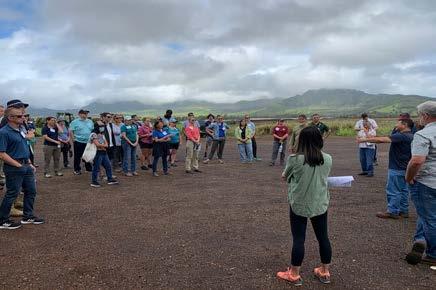

How does REPI prioritize projects in Hawai'i?
Project prioritization is an evolving process shaped by local, regional, state, and DOD stakeholders coordinating on the ground across the state in resource conservation. Notably, DOD and the TPL recently sponsored a forum to discuss this issue in person in order to maximize positive outcomes from growing the REPI Program in Hawai'i. From Oct. 24 to 27, 2022, the REPI Program hosted a series of meetings focused on FY23 REPI project development and how to hone sustainable resource management practices in Hawai'i. The forum incorporated local, regional, state, and federal perspectives into the conversation. Given the collaborative setting, DOD officials were able to learn more about Hawai'ibased issues and local perspectives and to discuss avenues for continued teamwork to develop meaningful solutions. During the workshop, local resource management practitioners explained that one of the most efficient ways to simultaneously promote cultural knowledge and enhance climate resilience and environmental protection is to use teachings from Kanaka Maoli— Native Hawaiians—who effectively and sustainably manage and preserve natural resources through ahupua'a delineations. In modern-day Hawai'i, ahupua'a serves as the framework for sustainable stewardship of the land, water, and other natural resources, while minimizing the exploitation of these resources. Modern ahupua'a land management prioritizes a need for humans and natural ecosystems to coexist by promoting pono practices— good and righteous practices—and providing proper care for the places that people occupy and rely upon through understanding appropriate behaviors given the time, place, and history.
REPI projects can empower local communities by bringing community leaders and government officials at all levels together to understand challenges and develop meaningful outcomes. When REPI projects are used to prioritize natural resource management through traditional and culturally astute practices, these initiatives become a tool that everyone can use and share to achieve collective goals of sustainable stewardship of the 'āina.
30 U.S. ARMY | EMP BULLETIN | 2022-2023
REPI
What are the current REPI projects in Hawai'i and anticipated efforts?
Hawai'i-based REPI initiatives include an enhanced focus on watershed conservation and the improvement of climate and coastal resilience. Along with local and regional partners and military services, the REPI Program is developing a coordinated funding strategy for REPI projects across Hawai'i in FY23 and the following four years. These projects will preserve and enhance key mission capabilities, promote natural and cultural resource conservation, and address climate change and resilience across the state. For FY22, the REPI Program awarded $2.4 million to Pohakuloa Training Area, in partnership with the Department of Land and Natural Resources, to promote climate resilience for wildfire prevention. Also in FY22, nearly $15 million was awarded to the State of Hawai'i, in partnership with the Navy, for the restoration and protection of the Waiawa Watershed. This REPI Challenge project will improve 7,155 acres of native upland forests to support recharge of the Pearl Harbor aquifer and reduce downstream flooding from storm events. In FY23, nearly $25 million in REPI and REPI Challenge projects will be awarded across the state, with diverse projects tackling climate resilience, species conservation, cultural resources, and the promotion of growth in farming in Hawai'i, while also preserving military mission throughout the state.
How is DOD committed to environmental preservation and resilience in Hawai'i?
DOD commits to engaging in and sustaining large-scale conservation projects to support climate resilience efforts
and natural resource protection by providing support for the important stewardship work that is already being done on the islands. Potential encroachment threats cannot be adequately addressed without also enabling the environmental protection efforts of local organizations and agencies that understand the land and the resources needed to protect it. To enhance the nation’s defense capabilities on lands shared by island communities, it is crucial that DOD collaborates with local conservationists who use nature-based solutions to strengthen forestry and coastal resilience and preservation.
Having the privilege to live, work in, or visit Hawai'i in any capacity means recognizing that it is everyone’s kuleana—or responsibility—to care for the land. Furthermore, we have a shared kuleana to respect the relationship that Native Hawaiians have with the land and how the cultural practices derived from this relationship shape the foundation of natural resource conservation in Hawai'i. The mountains and ocean are not only a playground for residents, but a source of life, and the foundation of the mauka-to-makai practices that should shape resource conservation in Hawai'i. Being part of an island community means understanding that, while the challenges one group faces may differ from their neighbors, we all share a collective goal of caring for the 'āina which provides for its inhabitants. The REPI Program in Hawai'i is dedicated to protection, preservation, and resilience through partnership and collaboration. Through this approach, knowledge of history, cultural practices, and effective stewardship tools and resources can be shared and enhanced as part of a collective effort to protect that which provides for all of us.
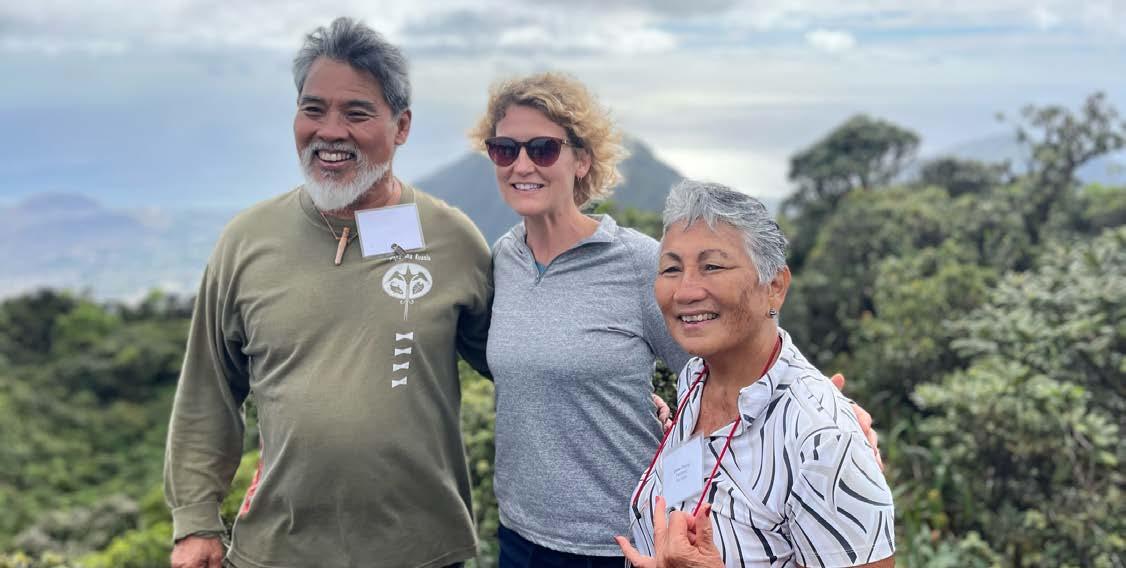 ABOVE Participants of a recent REPI workshop on O'ahu (left to right): Sam 'Ohukalani'ōhi'a Gon III, Senior Scientist and Cultural Advisor for The Nature Conservancy of Hawai'i, serving as cultural and spiritual advisor for the visit; Kristin Thomasgard, REPI Program Director; and Dawn Chang, principal of Ku'iwalu Strategic Planning and Facilitation Firm, serving as forum facilitator. PRECEDING PAGE, TOP Workshop participants visited Sentinel Landscapes including the agricultural fields at Lands of Līhu'e, which REPI contributed to protecting with partners from Federal and State agencies and non-governmental organizations. PRECEDING PAGE, BOTTOM U.S. Army Garrison Deputy Director Brandi Skasik (left), USAGHI Natural Resources Manager Kapua Kawelo (center), and Commanding Officer MCBH Colonel Speros Koumparakis, at the summit of Ka'ala.
ABOVE Participants of a recent REPI workshop on O'ahu (left to right): Sam 'Ohukalani'ōhi'a Gon III, Senior Scientist and Cultural Advisor for The Nature Conservancy of Hawai'i, serving as cultural and spiritual advisor for the visit; Kristin Thomasgard, REPI Program Director; and Dawn Chang, principal of Ku'iwalu Strategic Planning and Facilitation Firm, serving as forum facilitator. PRECEDING PAGE, TOP Workshop participants visited Sentinel Landscapes including the agricultural fields at Lands of Līhu'e, which REPI contributed to protecting with partners from Federal and State agencies and non-governmental organizations. PRECEDING PAGE, BOTTOM U.S. Army Garrison Deputy Director Brandi Skasik (left), USAGHI Natural Resources Manager Kapua Kawelo (center), and Commanding Officer MCBH Colonel Speros Koumparakis, at the summit of Ka'ala.
31
into your community Root

U.S. Army Garrison Hawai ' i Natural Resources Program
staff lead monthly volunteer service trips to protect rare and endangered plants and animals on Army-managed lands. Each educational trip incorporates hiking and a hands-on opportunity to care for Hawai'i's natural resources through invasive weed control in native habitat and occasional planting activities.
BECOME A VOLUNTEER
JOIN THE VOLUNTEER LISTSERV
Contact OUTREACH@OANRP . COM to be added to the volunteer database.
ORGANIZE A TRIP
Contact OUTREACH@OANRP.COM to organize a service opportunity for your class, hālau or group.

ABOUT U.S. ARMY GARRISON HAWAI ' I


U.S. Army Garrison Hawai ' i is responsible for the day-to-day operations of Army installations and training areas in Hawai ' i. U.S. Army Garrison Hawai ' i team provides facility management and quality Soldier and military family services for more than 95,000 Soldiers, retirees, civilians and families across 22 military installations and training areas on O ' ahu and Hawai ' i Island. These installations include O ' ahu-based Schofield Barracks, Wheeler Army Airfield, Fort Shafter, Tripler Army Medical Center, and the Island of Hawai ' i-based Pōhakuloa Training Area.
The Directorate of Public Works Environmental Division Office at U.S. Army Garrison Hawai'i is comprised of two branches: the Compliance Branch and the Conservation Branch, which are ded icated to providing guidance, support and liaison services to those who live, work and train on the installation, while also protecting the environment. The Conservation Branch includes the Army's Natural and Cultural Resources Programs, which protect endangered species and cultural resources, respectively, on O'ahu and Hawai'i Island. To learn more about the Army's environmental stewardship mission, visit HTTPS://HOME.ARMY.MIL/HAWAII/INDEX.PHP/GARRISON/DPW/
ABOUT THE OFFICE OF THE VICE PRESIDENT FOR RESEARCH AND INNOVATION (OVPRI)
The Office of the Vice President for Research and Innovation (OVPRI) provides leadership, coordination and support of research and innovation efforts throughout the 10-campus University of Hawai‘i System, including oversight of extramural funding, compliance, export controls, technology transfer and commercialization, and the Applied Research Laboratory at UH – one of only 13 U.S. Department of Defense University Affiliated Research Centers (UARC). Through a cooperative agreement, OVPRI supports U.S. Army Garrison Hawai‘i Natural Resources Program on O'ahu. For more about OVPRI, please visit: WWW.HAWAII.EDU/RESEARCH/
HO ‘ OA ‘ A


 MAKOA DE ALMEIDA
MAKOA DE ALMEIDA



 Steven B. McGunegle Colonel, U.S. Army Commanding
Steven B. McGunegle Colonel, U.S. Army Commanding










 RIGHT U.S. Army Maj. Gen. James T. Hill with a Hawaiian hāhā, or Cyanea superba, ssp. superba—the first recorded endangered plant reintroduction by the Department of Defense in Hawai'i.
RIGHT U.S. Army Maj. Gen. James T. Hill with a Hawaiian hāhā, or Cyanea superba, ssp. superba—the first recorded endangered plant reintroduction by the Department of Defense in Hawai'i.
 STORY BY KAPUA KAWELO & TIM CHAMBERS ILLUSTRATIONS BY TRESSA HOPPE
STORY BY KAPUA KAWELO & TIM CHAMBERS ILLUSTRATIONS BY TRESSA HOPPE


 Natural resources (NR) field supervisor, David Hoppe-Cruz (right), collects empty dibble-tubes while Aaron Pila (left), an NR management field technician, helps to plant hundreds of native plants in the Wai'anae Mountains.
Natural resources (NR) field supervisor, David Hoppe-Cruz (right), collects empty dibble-tubes while Aaron Pila (left), an NR management field technician, helps to plant hundreds of native plants in the Wai'anae Mountains.















 ABOVE AND PRECEDING SPREAD Variations of mature Tetramolopium species 1, an undescribed pamakani species at Pōhakuloa Training Area (PTA), soon to be renamed.
ABOVE AND PRECEDING SPREAD Variations of mature Tetramolopium species 1, an undescribed pamakani species at Pōhakuloa Training Area (PTA), soon to be renamed.



























 ABOVE Participants of a recent REPI workshop on O'ahu (left to right): Sam 'Ohukalani'ōhi'a Gon III, Senior Scientist and Cultural Advisor for The Nature Conservancy of Hawai'i, serving as cultural and spiritual advisor for the visit; Kristin Thomasgard, REPI Program Director; and Dawn Chang, principal of Ku'iwalu Strategic Planning and Facilitation Firm, serving as forum facilitator. PRECEDING PAGE, TOP Workshop participants visited Sentinel Landscapes including the agricultural fields at Lands of Līhu'e, which REPI contributed to protecting with partners from Federal and State agencies and non-governmental organizations. PRECEDING PAGE, BOTTOM U.S. Army Garrison Deputy Director Brandi Skasik (left), USAGHI Natural Resources Manager Kapua Kawelo (center), and Commanding Officer MCBH Colonel Speros Koumparakis, at the summit of Ka'ala.
ABOVE Participants of a recent REPI workshop on O'ahu (left to right): Sam 'Ohukalani'ōhi'a Gon III, Senior Scientist and Cultural Advisor for The Nature Conservancy of Hawai'i, serving as cultural and spiritual advisor for the visit; Kristin Thomasgard, REPI Program Director; and Dawn Chang, principal of Ku'iwalu Strategic Planning and Facilitation Firm, serving as forum facilitator. PRECEDING PAGE, TOP Workshop participants visited Sentinel Landscapes including the agricultural fields at Lands of Līhu'e, which REPI contributed to protecting with partners from Federal and State agencies and non-governmental organizations. PRECEDING PAGE, BOTTOM U.S. Army Garrison Deputy Director Brandi Skasik (left), USAGHI Natural Resources Manager Kapua Kawelo (center), and Commanding Officer MCBH Colonel Speros Koumparakis, at the summit of Ka'ala.



